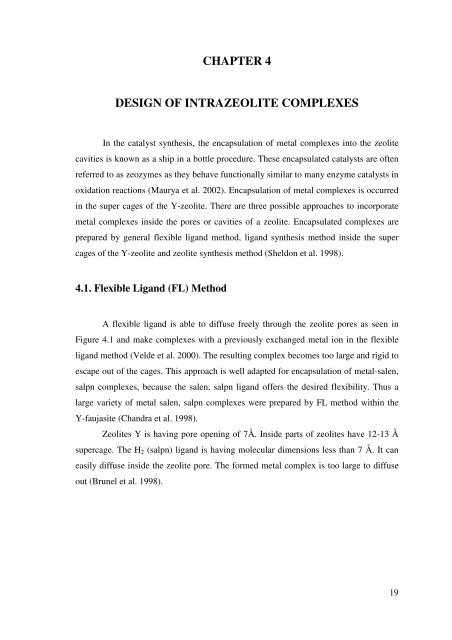the production of thymoquinone from thymol and carvacrol
the production of thymoquinone from thymol and carvacrol
the production of thymoquinone from thymol and carvacrol
Create successful ePaper yourself
Turn your PDF publications into a flip-book with our unique Google optimized e-Paper software.
CHAPTER 4<br />
DESIGN OF INTRAZEOLITE COMPLEXES<br />
In <strong>the</strong> catalyst syn<strong>the</strong>sis, <strong>the</strong> encapsulation <strong>of</strong> metal complexes into <strong>the</strong> zeolite<br />
cavities is known as a ship in a bottle procedure. These encapsulated catalysts are <strong>of</strong>ten<br />
referred to as zeozymes as <strong>the</strong>y behave functionally similar to many enzyme catalysts in<br />
oxidation reactions (Maurya et al. 2002). Encapsulation <strong>of</strong> metal complexes is occurred<br />
in <strong>the</strong> super cages <strong>of</strong> <strong>the</strong> Y-zeolite. There are three possible approaches to incorporate<br />
metal complexes inside <strong>the</strong> pores or cavities <strong>of</strong> a zeolite. Encapsulated complexes are<br />
prepared by general flexible lig<strong>and</strong> method, lig<strong>and</strong> syn<strong>the</strong>sis method inside <strong>the</strong> super<br />
cages <strong>of</strong> <strong>the</strong> Y-zeolite <strong>and</strong> zeolite syn<strong>the</strong>sis method (Sheldon et al. 1998).<br />
4.1. Flexible Lig<strong>and</strong> (FL) Method<br />
A flexible lig<strong>and</strong> is able to diffuse freely through <strong>the</strong> zeolite pores as seen in<br />
Figure 4.1 <strong>and</strong> make complexes with a previously exchanged metal ion in <strong>the</strong> flexible<br />
lig<strong>and</strong> method (Velde et al. 2000). The resulting complex becomes too large <strong>and</strong> rigid to<br />
escape out <strong>of</strong> <strong>the</strong> cages. This approach is well adapted for encapsulation <strong>of</strong> metal-salen,<br />
salpn complexes, because <strong>the</strong> salen, salpn lig<strong>and</strong> <strong>of</strong>fers <strong>the</strong> desired flexibility. Thus a<br />
large variety <strong>of</strong> metal salen, salpn complexes were prepared by FL method within <strong>the</strong><br />
Y-faujasite (Ch<strong>and</strong>ra et al. 1998).<br />
Zeolites Y is having pore opening <strong>of</strong> 7Å. Inside parts <strong>of</strong> zeolites have 12-13 Å<br />
supercage. The H2 (salpn) lig<strong>and</strong> is having molecular dimensions less than 7 Å. It can<br />
easily diffuse inside <strong>the</strong> zeolite pore. The formed metal complex is too large to diffuse<br />
out (Brunel et al. 1998).<br />
19
















